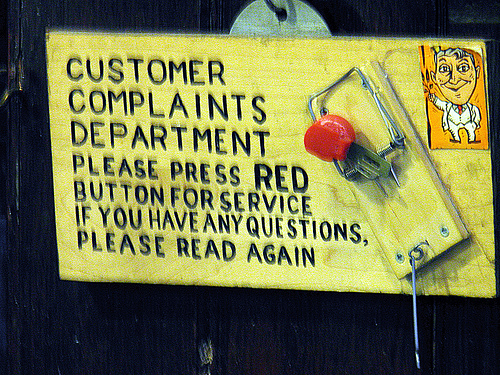Mike Petroff, Web Manager for Enrollment at Emerson College offers three building blocks for providing good customer service online for your university: Listen. Build. Scale.
The Customer Cycle
In higher education, much of our resources go toward brand management and image. How does customer service play a role in your university’s brand?
Brand Quality >> Regular Customers >> Word of Mouth >> New Customers >> Customer Experience
Many universities aren’t using social media to its potential. Putting time and money into brand messaging without being responsive for customers can result in lost customers.
“Stop treating your customers like one-night stands.” (Heh. –Ed.)
What does good customer service look like?
- Close, personal relationships with customers.
- Share product recommendations and personalize information.
- Reputation not bought, but earned by customer service.
How do we scale this sort of customer service and personal experience to make it usable in a marketing campaign?
Listen
- Set up listening stations. If departments across your campus aren’t listening effectively, opportunities and/or important campus information might be missed.
- Google alerts.
- Listening tools like Tweetdeck or Hootsuite. Hootsuite allows organization of internal staff by assigning tweets and responses.
- Go where your customers go (CollegeProwler.com, StudentsReview.com, Unigo.com, Yahoo Answers, Yelp, College Confidential).
Real-time Chat with Customers
- Example: Olark (@olark)
- Interact with people who visit your website without driving them to other channels.
- Personalize the web experience.
- Users spent 40% more time on e-commerce sites with live chat (source: Olark).
- Users were 300% more likely to return if they used live chat (source: Olark).
- “You have to out-care your competition.”
Crowdsource
- Use staff and students to create a shared space for answers (ex: http://sunyoswego.wikispot.org).
- Take the user knowledge to a public space and share it (ex: Get Satisfaction, UserVoice).
- Focus on being proactive, not reactive — building an internal social knowledge space is being proactive.
Facebook and Twitter
- Scale smart — Look for people talking about you and reach out to them.
- Find brand ambassadors — Develop a positive relationship with the people who are talking about you.
- 24/7 customer service!
- Need to respond? There’s a workflow for that… (ex: http://bit.ly/SM-response-guide).
As an example of how to turn a student comment into a marketing opportunity, Mike provided an example of an Emerson student who tweeted, “can @EmersonCollege and I just get married already?” The response included a campus hashtag and a question to deepen the conversation.
Learn from Xbox. Xbox has a very extensive FAQ site, support staff on Twitter (@XboxSupport). An internal database of information allows answers to be easily linked on Twitter.
Measure
- “Your audience wants their voice heard. Control their megaphone.”
- Give your audience a focal point for complaints.
- Feedback is powerful when it leads to change. What are you doing with the feedback you get?
Why it Matters
- Our Social Graph dominates how we interact on the web. Users aren’t just going to Facebook to get social recommendations. Social influence now exists all over the internet. CNN.com shows every story your friends share. ESPN shows users what people are most talking about. Bing results include what you’re friends have recommended. Google includes +1 information on search results.
- What people are saying about your college has just as much influence on customer perception as any marketing piece.
- After someone becomes a customer, support is what leads to loyalty and advocacy.
Listen. Build. Scale.
Questions from the Audience
Do you monitor misspellings or other keywords for your college?
Look at your web analytics to find out what search terms are leading people to you. Use those terms for monitoring, as well as common misspellings or internal terminology.
How does a social media ambassador program start?
Look to your Admissions tour guides as a starting point for social media ambassadors. Listen for people talking about your university already. Solicit help from followers.
How can someone balance their limited time for monitoring/responding?
What is making money for your university? Start at the points that lead to customers instead of trying to focus on everything at once. Once a base is established, scale from there.
How do you find out the hashtags students are using?
As soon as a student posts about your school, create a private Twitter list to follow. This will allow you to see how people talk about your university.
How do you build a knowledge database?
Find the most common questions. Create a shared document for compiling the answers. Make the information public in a useful way.
View Session Description and Presenter’s Bio.


One reply on “Customer Service & Social Media: You Can Do Better #heweb11”
[…] Customer Service & Social Media: You Can Do Better […]